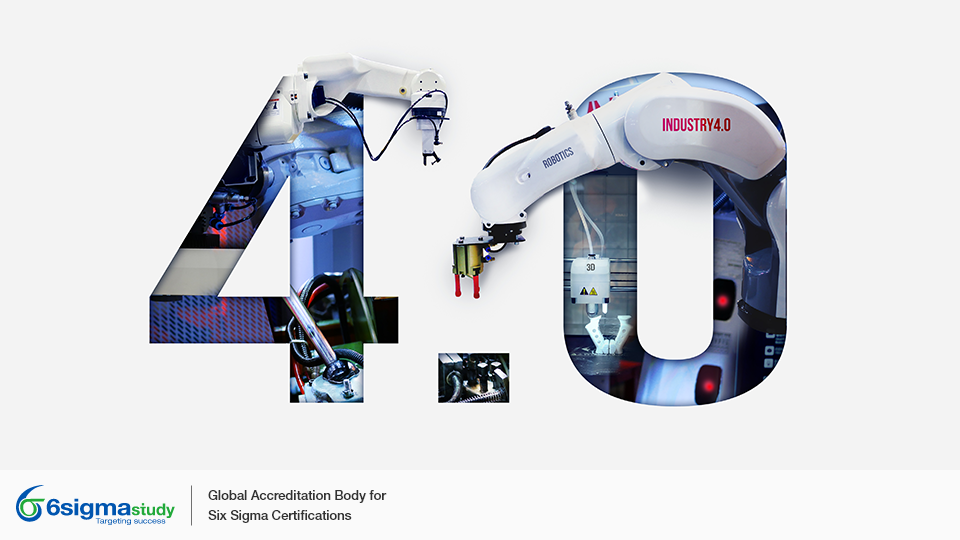Industry 4.0 Solutions and Lean Six Sigma Methodologies
Posted by 6sigmastudy® on January 09, 2024 | Six Sigma Methodology
Keywords: Six Sigma 6sigmastudy Industry 4.0 Six Sigma Yellow Belt (SSYB™) Six Sigma Green Belt (SSGB™) Six Sigma Black Belt (SSBB™) Lean Six Sigma Green Belt (LSSGB™) Lean Six Sigma Black Belt (LSSBB™) Free Articles Free Six Sigma Articles TQM Six sigma define dmaic dmadv
In today’s business world, companies must be agile, innovative, and committed to continuous improvement. Two strategies that are transforming the industry are Industry 4.0 and Lean Six Sigma. When combined, these approaches offer a powerful framework for optimizing production processes, improving product quality, and increasing profitability. Let's explore each concept individually before examining their integration. Industry 4.0 integrates advanced tech like AI, IIoT, and robotics into processes for enhanced efficiency, productivity, and quality. This transformative shift enables real-time monitoring, predictive maintenance, and customized products to meet changing demands.
By integrating Lean Six Sigma's efficient processes with Industry 4.0's advanced tech, companies can optimize production workflows, reduce waste, and enhance product quality. Combining Lean Six Sigma's agile processes with Industry 4.0's cutting-edge technology fosters a dynamic partnership.
Implementing Industry 4.0 solutions alongside Lean Six Sigma methods can bring about significant improvements in efficiency, productivity, and quality in processes:
- Evidence-Based Process Improvement: Modern Industry 4.0 tech generates tons of real-time data. When you blend this data with Lean Six Sigma's analytical methods, it becomes valuable insights. These insights help identify and predict issues, enabling smart decisions to make operations smoother and more efficient.
- Proactive Quality Control: Smart sensors in machines provide real-time health updates. By merging Lean Six Sigma practices into processes, companies efficiently tackle issues, cutting downtime and refining maintenance plans. This proactive approach signifies heightened efficiency and reduced costs. The smooth integration ensures operations run seamlessly, minimizing disruptions and maximizing the productivity.
- Streamlined Supply Management: The combination of data analytics, AI, and Lean Six Sigma in supply chains enhances forecasting, optimizes inventory, and simplifies logistics. This synergy leads to shorter lead times and cost savings. By using advanced technologies and efficient methodologies, businesses can predict demand accurately, manage inventory more effectively, and streamline the movement of goods. The result is a more responsive and cost-efficient supply chain.
- Flexible and Adaptive Production Systems: Industry 4.0 tech creates flexible systems that quickly adapt to market shifts and customer needs. Lean Six Sigma methods add to this adaptability by keeping processes efficient and responding fast to any deviations. Together, they create a dynamic approach that can swiftly adjust to changes, ensuring streamlined operations and a prompt reaction to any unexpected variations in the process.
- Comprehensive Defect Prevention: Combining advanced analytics, automation, and Lean Six Sigma principles enhances defect detection and minimizes variation, resulting in on-going improvements to product quality. By using cutting-edge technologies alongside a commitment to quality, this integrated approach ensures efficient identification and correction of defects, contributing to a continuous refinement of product quality.
Yet, integrating these approaches faces challenges. It requires a cultural shift, urging organizations to embrace technology while valuing constant improvement. Aligning stakeholders' mind-sets becomes crucial. Ensuring success in integration involves prioritizing workforce development. It's crucial to equip employees with the skills needed to effectively utilize advanced technologies and methodologies. This dual emphasis on both cultural change and skill development is vital for a seamless and successful integration process.
Industry 4.0 mixed with Lean Six Sigma signifies a revolution. This blend allows for smarter, more flexible, and efficient processes, encouraging on-going improvement and innovation. It's not just about using new tools; it's about creating a culture that values adaptability, innovation, and continuous learning. This cultural shift is essential for staying competitive in the ever-changing landscape. This cultural shift that organizations are more capable of adapting to challenges and driving excellence.
For more such interesting articles on Six Sigma and its concepts, please click here

